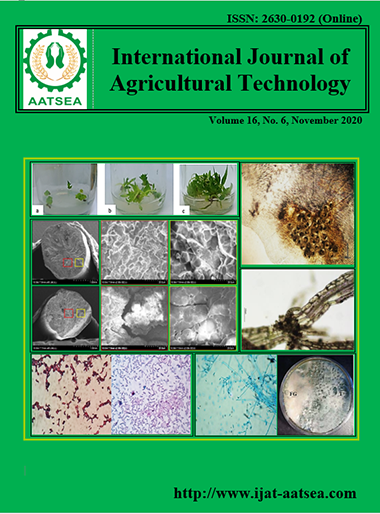Effects of different sources of probiotic encapsulation on some physico-chemical characteristics, viability, acceptability and its microstructure in probiotic salak juice
Main Article Content
Abstract
The results displayed that salak juice fermented with soygurt (richesse) had high acceptability with a score of 7.33 (moderately like). As a result of the living probiotic located in the capsules, there were little changes in the pH and titrable acidity which slightly decreased and then increased until fermentation reached at 30°C in 72 hours. Interestingly, the level of the living cells of all probiotic salak juices was at the standard level by the FAO/WHO (over 6 log CFU/ml) in all treatments. This encapsulation method protected the probiotic cells; therefore, the viability of the salak juice was slightly stable. However, the addition of the probitic calcium alginate capsules did not affect the vitamin C concentration. For the microstructure of the capsules, the SEM showed that all probiotic calcium alginate capsules were round and oval, and the probiotic cells were located in the capsules. Overall, these results could be an alternative healthy non-dairy probiotic source for vegetarians and milk-allergic consumers. Moreover, the highlight of research finding is the first novel non-dairy probiotic salak juice, which could provide health benefits from the fruit and living probiotic.
Article Details

This work is licensed under a Creative Commons Attribution-NonCommercial-NoDerivatives 4.0 International License.
References
AOAC (2000). Official methods of analysis. 17th edition. Association of Official AnalyticalChemists. USA.
Colombo, T., Suellen, P., Klososki, J., Rosset, M., Eduardo, C., Vanessa, B. and Marcolino, A. (2019). 14 - Fruit juices as probiotic foods. Sports and Energy Drink, 10:483-513.
Ding, W. K. and Shah N. P. (2008). Survival of free and microencapsulated probiotic bacteria in orange and apple juice. International of Food Research Journal, 15:219-232.
Herich, R. and Levkut, M. (2002). Lactic acid bacteria, probiotics and immune system. Veterinary Medicine – Czech, 6:169-180.
Ljungh, A. and Wadstrom, T. (2006). Lactic acid bacteria as probiotics. Current Issues in Intestinal Microbiology, 7:73-90.
Mazumdar, P., Pratama, H., Lau, S. E., Teo, C. H. and Harikrishna, A. (2019). Biology, phytochemical profile and prospects for snake fruit: An antioxidant rich fruit of South East Asia. Trends in Food Science & Technology, 9:147-158.
Mokarram, R. R., Mortazavi, S. A., Najafi, M. B. H. and Shahidi, F. (2009). The influence of multi stage alginate coating on survivability of potential probiotic bacteria in stimulated gastric and intestinal juice. Food Research International, 42:1040-1045.
Mongkontanawat, N. (2013). Product development of fruit tea mixed with “Hed Krang” (Schizophyllum commune). International Journal of Agricultural Technology, 9:1665-1676.
Mongkontanawat, N., Wongekalak, L., Nonmuang, W. and Thumrongchote, D. (2018). Yoghurt production from germinated native black rice (Maepayatong Dum Rice). International Journal of Agricultural Technology, 14:543-558.
Mongkontanawat, N., Laohkitikul, S. and Lertnimitmongkol, W. (2018). Fermentation of Gac juice mixture by probiotic lactic acid bacteria. International Journal of Agricultural Technology, 14:1455-1470.
Muthukumarasamy, P., Allan-Wojtas, P. and Holley, R. A. (2006). Stability of Lactobacillus reuteri in different types of microcapsules. Journal of Food Science, 71:M20-W24.
Nematollahi, A., Sohrabvandi, S., Mortazavian, A. M. and Jazaeri, S. (2016). Viability of probiotic bacteria and some chemical and sensory characteristics in cornelian cherry juice during cold storage. Electronic Journal of Biotechnology, 21:49-53.
Ortakci, F. and Sert, S. (2012). Stability of free and encapsulated Lactobacillus acidophilus ATCC 4356 in yogurt and in an artificial human gastric digestion system. Journal of Dairy Science, 56:6918-6925.
Panyanak, P., Suwanketnikom, S., Tonhang, S. and Siripoonwiwat, W. (2010). Correlations between seed characteristics, seed germination and -aminobutyric acid (GABA) content of 14 rice cultivars. Thai Journal of Botany, 2:97-113.
Reddy, V., Young, L., Wee, J., Reddy, V., Vinod, N. and Joshi, K. (2018). Chapter 4 - Development of New Probiotic Foods - A Case Study on Probiotic Juices. Therapeutic, Probiotic, and Unconventional Foods, 55-78.
Saleh, M. S. M., Siddiqui, M. J., Mediani, A., Ismail, N. H., Ahmed, Q. U., Soad, S. Z. M. and Saidi-Besbes, S. (2018). Salacca zalacca: A short review of the palm botany, pharmacological uses and phytochemistry. Asian Pacific Journal of Tropical Medicine, 11:645-652.
Sharma, V. and Mishra, H. N. (2008). Fermantation of vegetable juice mixture by probiotic lactic acid bacteria. Nutrafoods, 12:17-22.
Watts, B. M., Yumaki, C. L., Jeffery, L. E. and Elais, L. G. (1989). Basic sensory methods for food evalution. The International Development Research Centre, Ottawa, Canada, pp.159.
Zhao, R., Sun, J., Torley, P., Wang, D. and Niu, S. (2008). Measurement of particle diameter of Lactobacillus acidophilus microcapsule by spray drying and analysis on its microstructure. World Journal of Microbiology and Biotechnology, 24:1349-1354.
Zubaidah, E., Dewantari, F. J., Novitasari, F. R., Srianta, I. and Blanc, P. (2018). Potential of snake fruit (Salacca zalacca (Gaerth) Voss) for the development of a beverage through fermentation with the Kombucha consortium. Biocatalysis and Agricultural Biotechnology, 13:198-203.


